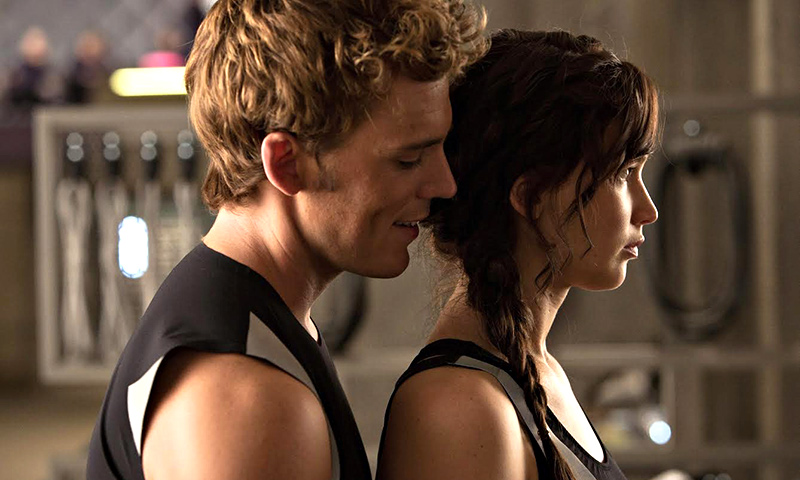
The bow and the arrows come out again, to satisfy television ratings and please totalitarian powers that be.

So, as I was saying: the job of the sequel is a straight forward one. Make you believe in where the characters are at the moment and what they are going through, so when the end starts maxing out, gaining momentum from one big pompous blockbuster event to another, side-stepping scenes where characters go through momentary emotional voids, we don’t miss the traumas that led them there. The sequels are, therefore, sometimes lingering and stale, because the characters have less to do.
In “Catching Fire”, based on Suzanne Collin’s wildly popular middle book, adapted by Simon Beaufoy (“127 Hours”, “Slumdog Millionaire”) and Michael deBruyn (an alias for writer Michael Arndt, “Little Miss Sunshine”, “Toy Story 3”), we see the characters do a lot of forced political round tripping across the 12 districts of Panem for the government.

Panem, for the uninitiated, is North America-redux: a setup of 12 divested townships of hard labor, low to no wages and no electricity (sounds somewhat like Pakistan, don’t it?), run by an authoritarian state-city called Capitol that makes the full use of the “rule with an iron fist” idiom. While the districts are downtrodden labor cities, the Capitol nevertheless is a place of drastic, daffy fashion sense gee-whiz future technology (if the cultural bomb has us dressed like taffy wrappers with puffy cotton candy wigs, then stop the train, I want out).
Anyways, the novelty in Panem is limited to their new-culture aesthetic and the need for television. Ergo, the great diversion: The Hunger Games – a sport where 24 younglings from 12 districts, between 12 to 18 years, who will serve as “tributes” and battle each other to the death for glory of television ratings.
Katniss Everdeen (Jennifer Lawrence), the survivor of the last Hunger Games, is an exception: she not only saved herself, but in a crafty moment of using the medium’s own entertainment value against itself, saves the boy from her district as well. Their price of living: they have to pretend to be in love. Often times in “Catching Fire” we are as strained as Katniss and Peeta Mellark (Josh Hutcherson, fine), because this is reality television at its most heartless.

When the movie opens, we see a shaky and haunted Katniss back in district 12. Her survivalist edge is down, because she sees dead people from the last Hunger Games (the trauma of being forced to kill a fellow human being lays pitiless on her soul).
She has slightly better accommodations though (the scarceness in Panem’s districts are often as hard as Ms. Lawrence’s breakthrough Oscar nominated movie “Winters Bone”). Her family is now living in a bigger house that’s 25 yards away from Peeta’s ditto-copied place. When cameras come by to check on her (which by the way look like automated monstrosities), the two slip off the snow and fake a kiss for live television. Circumstances, circumstances.
Soon, Katniss sees signs of a looming revolution with her Mocking Jay symbol at the forefront. The President of Panem (a crotchety Donald Sutherland) wants revenge for Katniss’ survival, and sets up the new Hunger Games with new games master Plutarch Heavensbee (Phillip Seymore Hoffman, subtle and at times too translucent in his characterization). The new twist is that Katniss and previous year’s survivors from the last Hunger Games from each district will be set loose against each other in a forest governed by barbaric man-made technology.

The new contestants includes a diverse age group from teens to eighty (actors Jeffrey Wright, Amanda Plummer, an immediately likable Jenna Malone and Sam Claflin), while the technology adds in everything from a small auto-timed tsunami, to barbarous baboons, poisonous fogs and birds that cry out the screams of previously dead combatants (now that was one scary moment, let me tell you).
It is nice, and mandatory, seeing everyone back. Lenny Kravitz’s fashion designer Cinna, Woody Harrelson’s drunk Haymitch Abernathy and Stanley Tucci’s plastic make-upped Caesar Flickerman, with a perpetual white-washed smile (that’s scarily always split open), have lesser parts in “Catching Fire”. A small, yet significant boost goes to Effie Trinket’s played by a terrific Elizabeth Banks in the worst-of get ups Panem Capitol fashion offers.
Director Francis Laurence (“Constantine”, “I AM Legend”) handles the drama – and the elongated running time – to the best. There is a prolonged buildup between Katniss, Peeta and even Gale (Liam Hemsworth), her other, real boyfriend. Although there is scarcely new ground to cover, Mr. Laurence, working from the already confined material, gives it enough punch to make “Catching Fire” one fine exceptions to sequels: he makes it engaging, and somewhat upsetting, without making it barefaced. (Like, the franchise needed any more obviousness than it already had).

Released by Lionsgate, “The Hunger Games: Catching Fire” is rated PG-13 for bloodless deaths and turmoil.
Directed by Francis Lawrence; Produced by Nina Jacobson and Jon Kilik; Written by Simon Beaufoy and Michael deBruyn (based on the novel by Suzanne Collins); Cinematography by Jo Willems; Edited by Alan Edward Bell; Music by James Newton Howard.
Starring: Jennifer Lawrence, Josh Hutcherson, Liam Hemsworth, Woody Harrelson, Elizabeth Banks, Lenny Kravitz, Philip Seymour Hoffman, Jeffrey Wright, Stanley Tucci, Willow Shields, Sam Claflin, Lynn Cohen, Jena Malone, Amanda Plummer, Paula Malcomson and Donald Sutherland.












































